How Cicada Urination Habits Can Shape Our Future and the Planet's Survival
Matthew Russell
Pexels
Cicadas, those ubiquitous heralds of summer, are not just known for their symphonic choruses. A recent study by researchers at the Georgia Institute of Technology has cast a spotlight on a less melodious, yet fascinating aspect of these insects: their unique method of urination.
Unlike many insects that expel waste in droplets, cicadas emit powerful jets of urine, challenging longstanding beliefs in fluid dynamics and offering potential insights for technological advancements and ecological studies.
 Photo: Pexels
Photo: PexelsCicadas belong to the family Cicadidae.
Observational Breakthrough in Cicada Behavior
For years, the peculiar urination pattern of cicadas remained elusive to scientists, largely due to the insects' preference for the seclusion of treetops. It was during fieldwork in Peru that researchers, including Professor Saad Bhamla, witnessed this phenomenon firsthand. The observation debunked the prevailing notion that insects feeding on xylem sap—like cicadas—would opt for droplet excretion to conserve energy, Earth reports, given the sap's low nutrient content.
Jet Urination: A Question of Energy and Size
The study, led by Elio Challita, former Ph.D. student in Bhamla’s lab and now a postdoctoral researcher at Harvard University, revealed that cicadas employ jet urination not just as a matter of preference, but as a necessity.
“The assumption was that if an insect transitions from droplet formation into a jet, it will require more energy because the insect would have to inject more speed,” Challita explained.
 Photo: Pexels
Photo: PexelsCicadas are found in temperate to tropical climates.
This is where the concepts of surface tension and viscous forces come into play. Surface tension is the elastic tendency of a fluid surface to minimize its area, like how water forms droplets on a waxed car surface. Viscous forces, on the other hand, are related to the internal friction within the fluid, which resists its flow, similar to how honey flows more slowly than water.
“Previously, it was understood that if a small animal wants to eject jets of water, then this becomes a bit challenging, because the animal expends more energy to force the fluid’s exit at a higher speed. This is due to surface tension and viscous forces. But a larger animal can rely on gravity and inertial forces to pee," Challita added.
In the case of cicadas, overcoming surface tension and viscous forces to eject a jet of urine requires more energy than simply letting droplets fall. However, the energy required to flick away individual droplets would outweigh the benefits for such voracious eaters, as reported by Phys.org.
This discovery challenges the conventional wisdom that smaller animals, constrained by the size of their orifices, are bound to droplet formation due to the higher energy costs of jetting. Cicadas, with their unique size and appetite, defy this limitation, demonstrating an extraordinary adaptation to their dietary habits and physical capabilities.
 Photo: Pexels
Photo: PexelsCicadas feed on the sap of plants and trees.
Implications Beyond Cicadas
The implications of this research extend far beyond the realm of entomology. The cicadas' ability to generate high-speed fluid jets, despite their small size, presents a model for the development of efficient jet mechanisms in microscale applications, such as robotics and spray nozzles, reports Interesting Engineering. Moreover, with cicada populations reaching into the trillions, understanding the ecological impact of their urination habits becomes imperative.
"Our research has mapped the excretory patterns of animals, spanning eight orders of scale from tiny cicadas to massive elephants," Bhamia said.
"We've identified the fundamental constraints and forces that dictate these processes, offering a new lens through which to understand the principles of excretion, a critical function of all living systems," he continued. "This work not only deepens our comprehension of biological functions but also paves the way for unifying the underlying principles that govern life's essential processes."
 Photo: Pexels
Photo: PexelsThe song of cicadas is considered one of the loudest in the insect world.
Mapping Excretory Patterns Across Species
Professor Bhamla's group has taken a broader view of fluid ejection across the animal kingdom, from microscopic fungi to whales. This comprehensive approach has unveiled the fundamental constraints and forces governing excretion, offering a new lens through which to understand a critical biological function, Phys.org reports.
The unifying framework established by the researchers not only deepens our understanding of life's essential processes but also paves the way for innovations in fields as diverse as soft robotics, additive manufacturing, and drug delivery.
Future Directions and Environmental Considerations
While the study has illuminated the mechanics of cicada urination, many questions remain, particularly regarding the environmental consequences of this mass excretory event. As the New York Times reports, cicadas, consuming 300 times their body weight in xylem sap daily, represent a significant bio-fluidic output whose ecological ramifications are yet to be fully understood.
The unique urination mechanism of cicadas has not only challenged existing paradigms in fluid dynamics but also opened new avenues for technological innovation and ecological research.
As scientists continue to unravel the mysteries of nature's minutiae, we are reminded of the intricate connections between biology, physics, and the broader environmental matrix.
Matthew Russell is a West Michigan native and with a background in journalism, data analysis, cartography and design thinking. He likes to learn new things and solve old problems whenever possible, and enjoys bicycling, spending time with his daughters, and coffee.




















